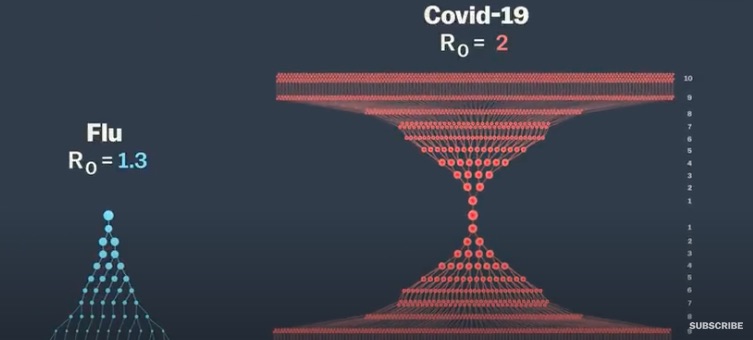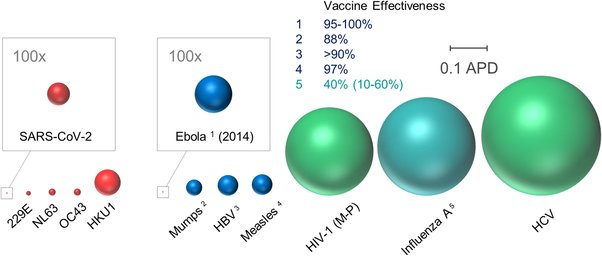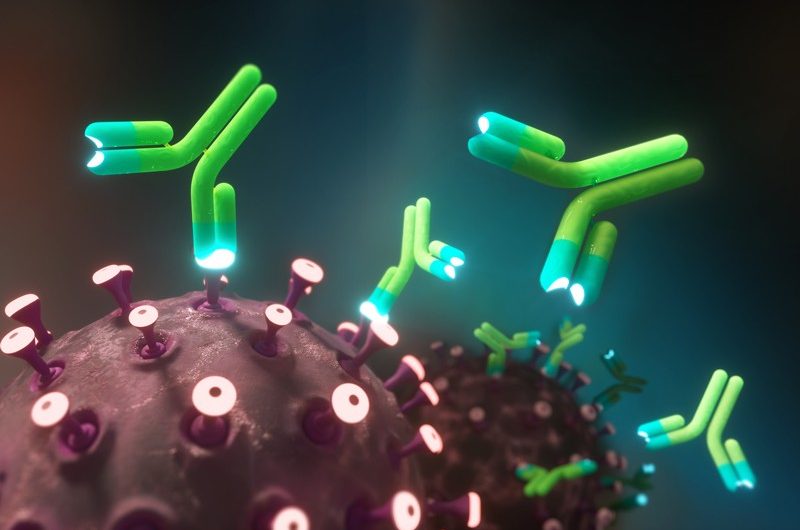Measles is one of the most contagious diseases we know. Just one person is likely to infect between 12 and 18 people.
That number is called a disease’s “basic reproduction number,” or R0. Scientists use it to describe how contagious a disease is.
Zika? It has an R0 of up to 6.6. Super contagious but the seasonal flu? Just a little over one and Covid-19, the disease caused by the coronavirus? R0 is just about two.
That difference, between the flu and Covid-19, doesn’t seem so big. Especially when you look at them next to these really contagious diseases.
Plus, a lot of the symptoms of the flu and Covid-19 are really similar: A fever, cough, they can even both lead to pneumonia, which is ultimately how they can both be fatal. So, thinking of Covid-19 and the flu as similar is a common, and frankly, understandable comparison to want to make. “This is like the flu.” “It’s a lot like the flu.” “I like to believe that it’s going to end up more like the flu virus.” But wait, let’s go back to those R0 numbers again.
If the flu has an R0 of 1.3, that means each person gets either one or two people sick after ten rounds, that’s 56 total people. If we run the model with Covid-19’s R0 at two, it means if one person with it gets two people sick, who then get two people sick… After ten similar rounds, that’s more than two thousand people. This does not happen with the flu.
Covid-19 is very different and understanding how is crucial to understanding how dangerous it really is. And why we have to take it so seriously.
When we start to look for that comparison to the flu, it seems minor in comparison unfortunately, that’s not quite the right reaction here.
Every year, the seasonal flu kills as many as 60,000 Americans. As of late March, Covid-19 has killed about 34,000 — across the whole world. But scientists expect that number to go up. Way up. Tens of thousands of people a year die of the flu.
But we haven’t had this for a year yet. We’ve only had this for a few months. The trouble is coming, and we can predict it, and we can see what’s coming, at least to a certain extent.
The first really big difference between Covid-19 and the flu is how long it takes you to feel sick. From the moment you’re infected with Covid-19, it usually takes five days before you start to feel symptoms but it can take as long as 12 or even 14 days.
This is the incubation period: the time between when you catch it, and when you first realise you’re sick and scientists think you could be contagious during most of this period.
The flu, by comparison, has an average incubation period of just two days. You get sick, and pretty soon you feel sick, and you know you’re contagious. This is what we’re used to. But Covid-19 flips that around.
You can be contagious and spreading it around for several days, and up to two weeks, before it even occurs to you that you’re sick. And that leads to the next big difference. No human immune system had seen this virus before. Very few has a natural immunity to it.
In flu season, there’s always a number of people in the population who are already immune to the flu. That can be because they got their flu shot, or maybe because they’ve already had that flu strain. And that limits the spread of the virus.
When one person is contagious with the flu, they can only spread it to people who aren’t immune. Who can only spread it to other people who aren’t immune. That’s why scientists and doctors urge us to get our flu shot every year: If enough people have immunity, they can kind of shield the virus from reaching others.
The more immunised people, the more they can protect those that are susceptible to the virus. But Covid-19 is brand new. None of us have had it before, and there’s no vaccine which means nearly everyone on the planet is susceptible.
So when a contagious person, who may not even know they’re infected, comes into contact with others, it can spread like wildfire so now you see how much more dangerous Covid-19 can be.
Only 2% of people with the flu need to be hospitalised but 20 to even 30% of people who test positive for Covid-19 do.
We’re still learning about Covid-19’s fatality rate, but scientists think it’s somewhere between 1 and 3% the flu’s rate is even lower: 0.1% and that’s a disease that can kill 60,000 people a year in the US alone.
“People always say, well, the flu does this, the flu does that. The flu has a mortality of 0.1%.
This has a mortality of ten times that.
This is a really serious problem that we have to take seriously.” And he’s just talking about the average across all age groups. For older people, or people with compromised immune systems, it can be way higher.
That’s especially scary when you remember all the other things that are different about Covid-19: The infectiousness, how hard it is to know that you have it, how susceptible we all are to it.
Estimates vary, but some scientists have warned that between 20 and 60% of the world’s population could become infected with the virus.
Because Covid-19 has no cure and no vaccine, the only defence we have against it is social. We can take ourselves out of the chain — not with immunity, but with social distancing.
Just physically not being around anyone, and staying home as much as possible. That only works if each of us takes it seriously.
Which is why comparing it to the flu, while understandable, is not helpful.nIt’s natural to want to find a comparison, to want to make this seem small.
When we use the flu as the backdrop, it almost numbs us, or it can numb us, and make us maybe even feel better about the current situation. Because the current situation is bad. So now is not the time to be numb.
We need to be vigilant, and then use our vigilance for useful actions.








